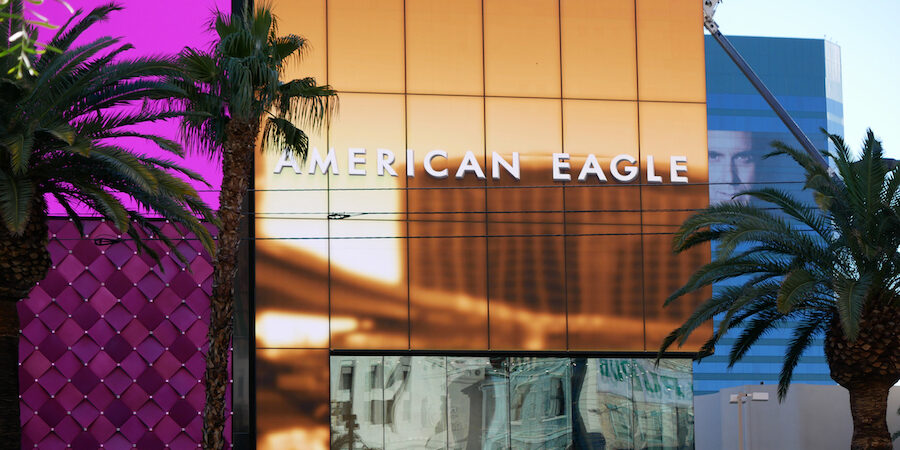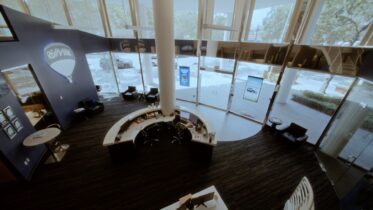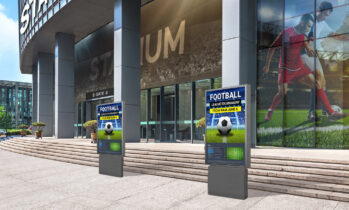The business benefits of outdoor signage are clear: In a study of small businesses that installed outdoor digital signage, 83 percent experienced an increase in sales post-installation. But the process of getting that signage implemented often discourages businesses from making the investment. Local signage regulations often appear time-intensive and frustrating to navigate, and fear of rejected permit applications or tedious back-and-forth with county officials often results in businesses settling for outdated static signage.
You can drastically simplify the permitting and installation process by having the right resources and accurate information upfront. Here are the most important questions to ask and pitfalls to avoid as you work to ensure regulatory compliance and high signage visibility for years to come.
1. Is digital signage allowed?
Start by answering the simple question of whether or not you’re allowed to install digital signage. Look around — is there already digital signage in your neighborhood? If not, outdoor signage may not be permitted in your area, or be difficult to get approved.
Your city or county government likely has an explanatory document of where outdoor digital signage is permitted, as well as the associated requirements. Some government offices have this information readily available on their website. If yours doesn’t, call the office or visit the planning and zoning department in person.
How to plan and deploy direct view LED signage
Everything you need to know about choosing your LED displays for optimal viewing indoors and out. Download Now
Government-imposed billboard regulations come in three teirs — federal, state and local — which means that zoning codes and permit requirements vary widely, even from one road to the next. When you check with your local offices, make sure you understand the approved uses for specific zones. Business-oriented local organizations, like your chamber of commerce, may also be able to explain local regulations to help companies successfully navigate the application and approval process. The International Sign Association also offers tutorials and zoning information for business reference.
Fortunately, it’s becoming less common for cities to entirely restrict digital signage, says Kevin Izatt, senior product manager of the Display division at Samsung Electronics America. “Most cities want to see businesses succeed, so they are opening channels and simplifying processes,” Izatt explains.
2. If signage isn’t allowed, what can you do?
Getting a permit is one thing. But if there aren’t applicable regulations in place, that doesn’t mean you should go straight to building.
In some cases, your business may want to try to work through the local legislative authorities to update their ordinances, outlining specific usage guidelines for digital displays. This will take strategic and informed lobbying efforts to persuade regulators that your proposed sign regulations are not only safe but also beneficial to the public — highlighting your signage’s potential to build business and increase tax revenue for the community.
When you partner with Samsung, representatives can travel and testify on your behalf before a planning commission, city council or legislative committee, meet with residents or business owners from your community and provide all the successful technical details and examples to demonstrate that your digital displays would be compliant and unobstrusive.
3. What local restrictions are in place?
Cities and counties typically have size restrictions for outdoor digital signage. These local regulations are generally based on square footage — the bigger a business’ space, the bigger the permitted signage.
Also make sure you know the local limit for signage brightness. The level may vary greatly by location, based on your neighbors. Most of the time, outdoor signs are not allowed to blink or flash to avoid distracting motorists. The majority of modern outdoor LED screens have an ambient light sensor that adjusts the screen’s brightness to match the environment. On sunny days, the screen is at its brightest. On overcast days, and even more so at night, the screen dims. Samsung LED signage includes additional failsafes, like local sunrise and sunset timetables built into the screens’ firmware to override the ambient sensor. If that sensor fails, the screen reverts to an auto-dimming mode.
Samsung’s LED signage, such as the XPR Series, also prioritizes durability and reliability, with built-in UV and weather protection to ensure longevity. LED signage from Samsung is designed to operate smoothly between −40 F and 131 F, with a 100,000-hour lifetime rating for 24/7 operation.
“Samsung uses tightly binned LEDs for great color performance and uniformity, and we oversize and underdrive them,” Izatt explains. “That allows us to gradually increase the LED current over time to compensate for aging and ensure constant, adaptive brightness for the longest period.”
4. What’s needed for the permit application?
When you’re applying for a digital signage permit, your biggest asset is data — and lots of it. Start with the physical designs for your proposed structure. How far is the billboard from the road? Is it engineered to current structural standards? Does it comply with usage and brightness regulations? As you gather this information, create a thorough packet of designs, stamped and signed by your engineer, with a detailed site plan to support it.
Your business may not have to alleviate fears and present the community benefits in order to receive a signage permit, but you should be prepared just in case. Community safety is typically the main concern. Your best resource is research on digital signage brightness and traffic safety. You can also highlight the community benefits of your proposed signage, such as the ability to communicate widely relevant information like weather alerts. Samsung can help during this stage by collecting objective research data and compiling reports.
5. How should you pick an installer and provider?
The biggest mistake you can make in applying for a signage permit is trying to go it alone. Having someone on your side — who knows both the technicalities of the digital display business and the details of signage regulations — makes everything easier.
To help ensure your signage project is successful, find a partner with a solid construction background and experience installing your chosen displays, as well as a working knowledge of local zoning and permitting issues.
In choosing a signage provider, there are several factors to consider, including price, performance, warranty, operational uptime and ease of content creation and management. Also key is your confidence in the brand — will they be around in five or 10 years to continue servicing your screens?
Above all, be a good neighbor
The goal of digital signage is to communicate with your community and drive sales, not cause conflict. If your community is adamantly against digital signage, you probably shouldn’t forge ahead. Starting an unpopular project against your customers’ wishes can be detrimental to your brand. And if your sign aggravates the public or your neighbors, regulators may impose unnecessarily strict regulations for the future, making it more difficult for other businesses to obtain a permit, or for your business to reapply.
Installing LED signage can be a worthwhile investment for a business and the greater community, but you’ll need to do your homework, studying the local rules and preferences before designing your signage strategy.
Discover the unique advantages of direct view LED technology over traditional LCD displays in this free guide to the rapidly advancing technology. And if your business could use some indoor upgrades, consider adding LED signage there, too, with individual LED screens or with your fully customized version of The Wall.








